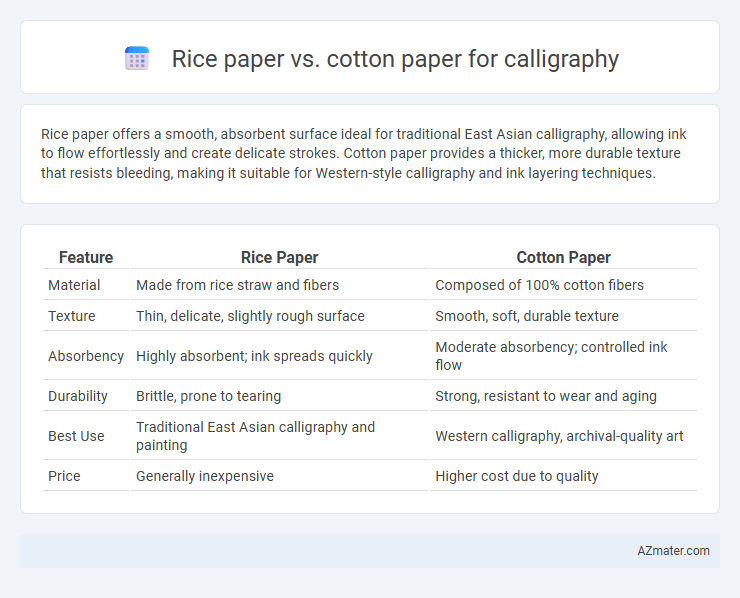Rice paper offers a smooth, absorbent surface ideal for traditional East Asian calligraphy, allowing ink to flow effortlessly and create delicate strokes. Cotton paper provides a thicker, more durable texture that resists bleeding, making it suitable for Western-style calligraphy and ink layering techniques.
Table of Comparison
| Feature | Rice Paper | Cotton Paper |
|---|---|---|
| Material | Made from rice straw and fibers | Composed of 100% cotton fibers |
| Texture | Thin, delicate, slightly rough surface | Smooth, soft, durable texture |
| Absorbency | Highly absorbent; ink spreads quickly | Moderate absorbency; controlled ink flow |
| Durability | Brittle, prone to tearing | Strong, resistant to wear and aging |
| Best Use | Traditional East Asian calligraphy and painting | Western calligraphy, archival-quality art |
| Price | Generally inexpensive | Higher cost due to quality |
Introduction to Rice Paper and Cotton Paper
Rice paper, made from the pith of the rice plant or other natural fibers, offers a smooth texture ideal for traditional Asian calligraphy and ink painting, enhancing brush control and ink absorption. Cotton paper, composed primarily of 100% cotton fibers, provides durability and a textured surface that supports Western calligraphy styles and fine pen work with superior archival quality. Both papers differ significantly in fiber composition and surface characteristics, affecting ink flow, drying time, and overall aesthetic outcomes in calligraphy art.
Historical Background of Calligraphy Papers
Rice paper, traditionally used in East Asian calligraphy, traces its origins to ancient China during the Han Dynasty, prized for its smooth texture and absorbency that facilitates intricate brush strokes. Cotton paper, developed later in the Islamic Golden Age and refined in Europe, offers durability and a consistent texture suited for various calligraphy styles, especially Western scripts. The historical preference for rice paper in East Asian art contrasts with the widespread use of cotton paper in Western calligraphy, highlighting cultural and material influences on artistic techniques.
Material Composition: Rice Paper vs Cotton Paper
Rice paper, traditionally made from the pith of the rice plant or mulberry fibers, offers a delicate, absorbent surface ideal for brush strokes in calligraphy. In contrast, cotton paper consists primarily of long cotton fibers that create a durable, textured surface with excellent ink retention, providing greater resistance to bleed and feathering. The material composition influences the final artwork's appearance, with rice paper enhancing fluidity and softness, while cotton paper emphasizes longevity and crisp line quality.
Texture and Surface Differences
Rice paper features a delicate texture with a smooth, absorbent surface that allows ink to flow freely, creating soft, fluid strokes ideal for traditional calligraphy. Cotton paper offers a thicker, more textured surface with greater durability, providing enhanced control for precise, sharp lines and minimizing ink bleed. The surface of rice paper tends to be more fragile and porous, while cotton paper's robust fibers deliver consistent performance suitable for advanced calligraphy techniques.
Ink Absorption and Flow Qualities
Rice paper exhibits high ink absorption, creating rich, vibrant strokes ideal for sumi-e and traditional East Asian calligraphy, but it can cause ink to bleed and blur fine details. Cotton paper offers moderate absorption with a smoother surface that preserves line clarity and allows controlled ink flow, making it preferred for Western calligraphy styles and detailed pen work. The choice between rice and cotton paper depends on desired ink diffusion and the precision of brush strokes in calligraphic art.
Durability and Longevity in Artworks
Rice paper, known for its delicate texture and lightweight nature, offers a traditional surface favored in calligraphy but tends to be less durable and more prone to tearing and yellowing over time. Cotton paper, composed of 100% cotton fibers, exhibits superior strength, resilience, and acid-free properties, ensuring greater longevity and resistance to aging in artworks. Artists seeking durable calligraphic pieces often prefer cotton paper for its stability and archival quality, which preserves the vibrancy and integrity of inks over extended periods.
Color and Aesthetic Appearance
Rice paper offers a translucent, delicate texture that enhances the subtle ink diffusion, creating a soft, ethereal aesthetic ideal for traditional calligraphy. Cotton paper features a smooth, consistent surface with a warmer, richer tone that highlights bold, vibrant brushstrokes and provides durability for detailed work. Artists often choose rice paper for its elegant lightness and cotton paper for its robust color retention and classic finish.
Suitability for Different Calligraphy Styles
Rice paper offers a smooth, absorbent surface ideal for traditional East Asian calligraphy styles like Chinese and Japanese brush writing, where ink flow and brush control are crucial. Cotton paper provides greater texture and durability, making it suitable for Western calligraphy styles such as Gothic and Italic that require precision and the use of dip pens or fountain pens. The choice between rice and cotton paper depends on the desired ink absorption, brush technique, and the aesthetic characteristics of the specific calligraphy style.
Cost and Accessibility Compared
Rice paper is generally more expensive and less accessible due to its delicate nature and traditional manufacturing process, often imported from East Asia. Cotton paper, widely produced and durable, tends to be more affordable and readily available in art supply stores globally. Artists seeking cost-effective and accessible options frequently prefer cotton paper for calligraphy practice and projects.
Choosing the Right Paper for Your Calligraphy Projects
Rice paper offers a lightweight, smooth surface ideal for delicate brush strokes and ink absorption, enhancing traditional Asian calligraphy styles. Cotton paper provides a durable, textured finish that supports a variety of ink types and prevents bleeding, making it suitable for Western calligraphy and mixed media projects. Selecting the right paper depends on your ink choice, desired texture, and project longevity to achieve crisp lines and vibrant results.

Infographic: Rice paper vs Cotton paper for Calligraphy
 azmater.com
azmater.com